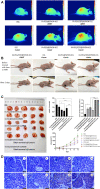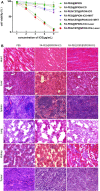Synthesis and Photothermal Effects of Intracellular Aggregating Nanodrugs Targeting Nasopharyngeal Carcinoma
- PMID: 34604188
- PMCID: PMC8481884
- DOI: 10.3389/fbioe.2021.730925
Synthesis and Photothermal Effects of Intracellular Aggregating Nanodrugs Targeting Nasopharyngeal Carcinoma
Abstract
Chemotherapy for the treatment of nasopharyngeal carcinoma (NPC) is usually associated with many side effects; therefore, its treatment options have not yet been completely resolved. Improving distribution to the targeted tumor region and enhancing the cellular uptake of drugs can efficiently alleviate the above adverse medical effects. Near-infrared (NIR) laser light-mediated photothermal therapy (PTT) and photodynamic therapy (PDT) are promising strategies for cancer treatment. In the present study, we developed an efficient multifunctional nanocluster with enhanced targeting and aggregation efficiency for PTT and PDT that is composed of a biocompatible folic acid (FA), indocyanine green (ICG) and 2-cyanobenzothiazole (CBT)-functionalized peptide labeled with an aldehyde sodium alginate-modified magnetic iron oxide nanoparticle (ASA-MNP)-based nanocarrier. FA can bind to folate receptors on cancer cell membranes to enhance nanocluster uptake. CBT-modified peptide can react with glutathione (GSH), which is typically present at higher levels in cancer cells, to form intracellular aggregates and increase the local concentration of the nanodrug. In in vitro studies, these nanodrugs displayed the desired uptake capacity by NPC cells and the ability to suppress the growth of cancer cells under laser irradiation. Animal studies validated that these nanodrugs are safe and nontoxic, efficiently accumulate in NPC tumor sites following injection via the caudal vein, and shows superior inhibition of tumor growth in a tumor-bearing mouse model upon near-infrared laser irradiation. The results indicate the potential application of the multifunctional nanoparticles (NPs), which can be used as a new method for the treatment of folate receptor-positive NPC.
Keywords: folic acid targeting; indocyanine green; intracellular aggregation; nasopharyngeal carcinoma; photothermal effect.
Copyright © 2021 Zhong, Bejjanki, Miao, Weng, Li, Zhang, Liu, Vannam and Xie.
Conflict of interest statement
RV was employed by Piramal Pharma Solutions. The remaining authors declare that the research was conducted in the absence of any commercial or financial relationships that could be construed as a potential conflict of interest.
Figures






Similar articles
-
Carrier-free nanodrug by co-assembly of chemotherapeutic agent and photosensitizer for cancer imaging and chemo-photo combination therapy.Acta Biomater. 2018 Apr 1;70:197-210. doi: 10.1016/j.actbio.2018.01.028. Epub 2018 Feb 13. Acta Biomater. 2018. PMID: 29408311
-
Near-Infrared Light-Triggered Generation of Reactive Oxygen Species and Induction of Local Hyperthermia from Indocyanine Green Encapsulated Mesoporous Silica-Coated Graphene Oxide for Colorectal Cancer Therapy.Antioxidants (Basel). 2022 Jan 17;11(1):174. doi: 10.3390/antiox11010174. Antioxidants (Basel). 2022. PMID: 35052678 Free PMC article.
-
Surface charge transition nano-theranostics based on ultra-small Fe3O4 nanoparticles for enhanced photodynamic and photothermal therapy against nasopharyngeal carcinoma.Biochem Biophys Res Commun. 2021 Jun 11;557:240-246. doi: 10.1016/j.bbrc.2021.03.168. Epub 2021 Apr 21. Biochem Biophys Res Commun. 2021. PMID: 33894409
-
Harnessing the power of targeted metal nanocarriers mediated photodynamic and photothermal therapy.Nanomedicine (Lond). 2024 Nov 15:1-19. doi: 10.1080/17435889.2024.2419820. Online ahead of print. Nanomedicine (Lond). 2024. PMID: 39545609 Review.
-
Self-Assembled Peptide-Based Nanodrugs: Molecular Design, Synthesis, Functionalization, and Targeted Tumor Bioimaging and Biotherapy.Small. 2023 Jan;19(3):e2205787. doi: 10.1002/smll.202205787. Epub 2022 Nov 28. Small. 2023. PMID: 36440657 Review.
Cited by
-
Current Challenges and Opportunities of Photodynamic Therapy against Cancer.Pharmaceutics. 2023 Jan 18;15(2):330. doi: 10.3390/pharmaceutics15020330. Pharmaceutics. 2023. PMID: 36839652 Free PMC article. Review.
-
Hypericin Nanoparticles-Associated Photodynamic Therapy Modulates the Biological Behavior of Hepatocellular Carcinoma by SERPINE1.Int J Nanomedicine. 2025 Mar 20;20:3713-3730. doi: 10.2147/IJN.S507037. eCollection 2025. Int J Nanomedicine. 2025. PMID: 40130195 Free PMC article.
-
Targeted Nanoparticle-Based Therapies for Nasopharyngeal Carcinoma: Enhancing Radiosensitization, Photothermal Therapy, and Diagnostics.Int J Nanomedicine. 2025 May 30;20:7021-7035. doi: 10.2147/IJN.S523213. eCollection 2025. Int J Nanomedicine. 2025. PMID: 40470111 Free PMC article. Review.
-
Noninvasive Photothermal Therapy of Nasopharyngeal Cancer Guided by High Efficiency Optical-Absorption Nanomaterial Enhanced by NIR-II Photoacoustic Imaging.Int J Nanomedicine. 2024 Jul 31;19:7817-7830. doi: 10.2147/IJN.S457069. eCollection 2024. Int J Nanomedicine. 2024. PMID: 39099790 Free PMC article.
-
Multi-Modal Optical Imaging and Combined Phototherapy of Nasopharyngeal Carcinoma Based on a Nanoplatform.Int J Nanomedicine. 2022 May 26;17:2435-2446. doi: 10.2147/IJN.S357493. eCollection 2022. Int J Nanomedicine. 2022. PMID: 35656166 Free PMC article. Review.
References
-
- Apalla Z., Sotiriou E., Chovarda E., Lefaki I., Devliotou-Panagiotidou D., Ioannides D. (2010). Skin Cancer: Preventive Photodynamic Therapy in Patients with Face and Scalp Cancerization. A Randomized Placebo-Controlled Study. Br. J. Dermatol. 162, 171–175. 10.1111/j.1365-2133.2009.09492.x - DOI - PubMed
LinkOut - more resources
Full Text Sources
Miscellaneous

